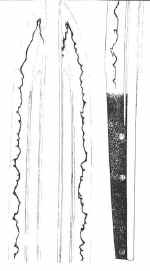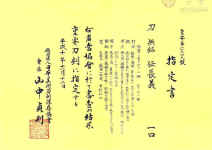
NBTHK Juyo Oshigata

NBTHK Juyo Papers |
BIZEN OSAFUNE NAGAYOSHI
備前長船長義
THE SODEN SCHOOL OF CHOGI
by Richard Mantegani
The late Kamakura period Japanese sword is often described as the
greatest edged weapon ever made. It certainly was an epoch in the long history
of Japanese sword making. By then the Soshu tradition had emerged as the
dominant force in further guiding the evolution and development of the sword. In
Sagami province, smiths like Kunitsuna and Sukezane combined many of the best
elements found in the Yamashiro and Bizen traditions. The famous group of sword
smiths that followed them culminated with Masamune and his school. Magnificent
blades were produced in grand shapes and proportions that had not been seen
before this time. Forged and laminated with as many as five separate pieces and
heat-treated (the edge hardened & tempered) at mostly higher temperatures,
these works were on the whole much more free and lively in their appearance. The
blade surfaces displayed a well worked itame hada often mixed with mokume and
covered with nie in such amounts as to seem almost layered on. The edge steel
after hardening produced equally bold workings [hataraki], again with strong nie
and kinsuji that weave around and through the hamon. Many of the swords made in
this manner were stronger and harder overall than what had been produced up to
that time. Perhaps this kind of blade was [more] brittle and prone to chipping
too, but they were sharper and simply cut better than others. In looking at them
today, and usually in a greatly shortened and reduced state, it is still very
easy to see why they were so popular. Simply put, Soshu swords show well, even
at a distance. The owner of such a blade was easily carrying "the biggest
stick".
During the early part of the 14th century, the school of Masamune was attracting
many new "students" or converts to their style of sword making.
Clearly, Soshu den was sending many innovative 'fingers of influence' to the
farthest reaches of Japan. Men who had spent most of their time forging swords
in just one tradition were now experimenting with these new ideas. It has often
been written that Masamune [is supposed to have] trained a select group of at
least ten pupils. The list is well known and among the ten brilliant disciples
were two smiths from Bizen province, Kanemitsu and Nagayoshi.
Kanemitsu is usually credited with having started the Soden School, which
successfully combined Bizen and Soshu forging techniques. Chogi was active at
about the same time, so perhaps he should share this honor as well. Indeed, as
is most often the case, the works of Chogi show a stronger use of the Soshu
tradition than does Kanemitsu. Signed and dated tanto were often produced, and a
small number of long swords still exist, but rarely with their mei intact. Most
of the surviving signed and dated examples of Nagayoshi [Chogi] can be placed in
time around that of Shochu [1324-25], through Oan [1368-74]. He is generally
accepted as having worked around the Embun and Joji eras [1356 or 1362].
It is interesting to note that unsigned and attributed blades done in Yoshino
era wide body configurations are fashioned more in the true Soden style than the
signed works are. Much can be left to speculation here, but it appears that
current scholarship tends to dismiss a direct relationship by Chogi with
Masamune and his school. Nagayoshi like so many other sword smith's who worked
during this period of time, was very likely caught up with all of the excitement
and changes brought on by the 'new wave' of Soshu. He sought to make a better
product by utilizing the best elements from both the Bizen and Soshu schools in
his own work. Surely to him, recent history had showed this to be a proven
formula for success. At a minimum, it can be said that Nagayoshi was a greatly
skilled [Bizen] smith who broke almost cleanly away from this long established
and original tradition(s). The fact that he could produce such great blades that
combined the softer Bizen steel production with the higher temperature nie-deki
hardening methods used at Soshu, is proof of that. Although often only faintly
visible, it is remarkable that Chogi was still able to create an utsuri on many
of his blades.
The Nambokucho period saw the introduction of the o-dachi, a blade that could
easily exceed three shaku in length. The intense fighting occurring at that time
required a longer weapon of greater strength to gain an advantage over an
opponent. The first blow delivered by such a sword would often be the last and
deciding one. Den Chogi likely produced many such pieces by the middle of the
14th century.
A variety of highly refined forging methods were used to make these tremendous
weapons. He and his group members produced an excellent itame and mokume hada
covered with fine quality nie and large pattern chikei. Yubashiri and tobiyaki
can be seen on these works, and especially on tanto. The grain will stand out
clearly within the tempered area of the blade. A distinctive hamon was often
done in large patterns of gunome midare/notare mixed with choji and wide valley
midare. It still has a clearly defined nioi-line but there is much nie clustered
all around it and they will form ashi and yo. Doubled gunome and mimi-gata [ear
shaped] and yama-gata [mountain shapes] are peculiar to Chogi and much nie and
sunagashi is worked in. Kinsuji, and inazuma are often seen. The boshi is
straight or in a subtle midare and flame shaped or pointed with a long kaeri
that runs down the mune. When taken altogether, the connections to Kanemitsu and
to Soshu are evident. It can be said that [den] Chogi's swords were for the most
part much more lively than Kanemitsu's. The word in Japanese is 'Hade'. These
characteristics as just noted, will make a [den] Chogi blade resemble to some
degree the works of Soshu Akihiro, Hiromitsu, or the Sa smiths.
Hi and carvings are found with combinations of Bo-hi, soe hi, and futasuji hi
being the most common. Bonji are rare but carved on occasion along with
inscriptions like Hachimon Daibosatsu, or other Buddhist deity names.
When seen in ubu condition, the nakago is finished in kurijiri with suji chigai
yasurime. The inscriptions are long. Some examples of signatures include:
BIZEN [NO] KUNI OSAFUNE JU NAGAYOSHI (備前国長船住長義)
BISHU OSAFUNE JU NAGAYOSHI (備州長船住長義)
Some of the following dates are inscribed as well:
SHOHEI JUSHICHINEN HACHIGATSU HI
OAN ROKUNEN HACHIGATSU HI
OAN SANNEN HACHIGATSU HI
Over the years, Nagayoshi's swords have held a great reputation for sharpness,
and were given a ryowazamono rating. A number of his works as well as those of
his students have been designated Juyo Token or better. At least four of Chogi's
swords are scheduled as Kokuho. A masterpiece called the "Osaka Chogi"
was one of the prized possessions of Toyotomi Hideyoshi.
Of the sword smiths that worked in the Den with Nagayoshi, the more notable ones
include the second Chogi [Nagayoshi II.], Nagashige, who was likely an older
brother of Chogi's, Kaneshige, and Kanenaga [Kensho].
A genealogy of the group is as follows:
CHOGI I. [KEMMU ERA]
CHOGI II. [EIWA], NAGATSUNA [EIWA], NAGAMORI [EMBUN], NAGASUKE [EIWA], NAGATSUNA [JOJI].
NAGASHIGE [KEMMU], NAGAYOSHI [JITOKU], YASUNOBU [OEI].
KANESHIGE [KEMMU], KANENAGA [JOJI].
Additional information on Osafune Nagayoshi can be found in the following
published works:
Nihonto Newsletter by Albert Yamanaka, Volume 3, #7 pp.6-8.
Japanese Swords and Fittings from the Collection of Dr. Walter A. Compton
[Auction Catalog Part 1] pp. 156-7.
Kotohen by Fujishiro [Koto AFU], translated by Harry Watson, pp.99-100.
|